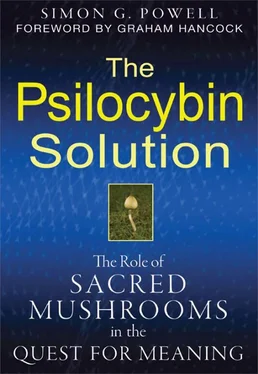As stated elsewhere, psilocybin mushrooms of one sort or another grow throughout the world—all over Europe, North and South America, Australia, New Zealand, Indonesia, Thailand, and Africa, for example. It seems that new psilocybin species are continually being discovered. But what is more astonishing than this biospherical bounty is the commercial availability of psilocybin mushroom spores as well as growing kits. In many European countries it is now possible to purchase such equipment. However, the various legal issues involved in cultivating the mushroom are far from clear at this time.
Under some European laws the fresh psilocybin mushroom is not controlled (at least at the time of writing). This means that the wild mushroom is not listed as a controlled substance, and personal mushroom use is allowed (but not their sale). In the United Kingdom, until recently only the isolated active ingredients psilocybin and psilocin were controlled by law (their classification as highly dangerous is questionable and may well be challenged in the coming years). Thus, as long as the mushroom remained in its raw, unprocessed state, it was deemed legal by the United Kingdom authorities. However, 2005 saw the United Kingdom government illegalize the actual wild mushroom itself. This was unprecedented, as it was the first time that a natural part of the United Kingdom countryside had been deemed illegal.
It remains to be seen what becomes of this unwarranted draconian measure that, by condemning a natural and long-revered environmental resource, can serve only to further alienate us from Nature. Indeed, one might think that notice boards ought to be placed throughout all the parks and wilderness areas of the United Kingdom warning citizens of the extreme dangers of naturally occurring psilocybin mushrooms (simple possession of the mushroom could entail a jail sentence). Having personally observed prolific numbers of Psilocybe semilanceata growing in most of the United Kingdom’s countryside areas during the autumn months (this includes the whole of the Lake District; the whole of Snowdonia; the whole of Dartmoor; the Devonshire coast; the Welsh coast; as well as London’s Richmond Park, Streatham Common, and Hampstead Heath), there would need to be thousands of such notice boards. Unless, that is, the government proposes drenching all wild, green areas with millions of gallons of eco-unfriendly fungicide. Or create a vast group of Rangers (with a tactical airborne division) to scour and police every inch of the countryside. Or simply seal off the countryside and people’s gardens (including land owned by the Queen) until further notice.
Of course, I am being deliberately provocative here—but only to highlight the absurdity of making a natural part of the environment illegal. In any case, these laws have not prevented the sale of psilocybin mushroom spores ( Psilocybe spores do not contain psilocybin) nor the growth media in which to cultivate them. The only feasible way to prevent this kind of activity would be to ban the air itself, as fungal spores of one kind or another are omnipresent.
If the more cautious reader is concerned with the health risks associated with consumption of the mushroom, we should note that a 2000 report from a Dutch Risk Assessment Team (copies of the report, by CAM—the Coordination Centre for the Assessment and Monitoring of New Drugs—can be located on the Internet) found that psilocybin mushroom use does not present a significant public health risk (at the time of the report, the mushroom had been commercially available in the Netherlands for many years). {49} 49 2. “CAM Risk Assessment Report Concerning Magic Mushrooms,” 2000, www.erowid.org/plants/mushrooms/mushrooms_health1.pdf (accessed March 11, 2011).
Similarly, a rigorous scientific study by Hasler and others published in 2004 showed that psilocybin was not hazardous to health when administered to healthy persons (although the study recommended that those with high blood pressure should abstain from psilocybin use). {50} 50 3. Hasler et al., “Acute Psychological and Physiological Effects of Psilocybin.”
A United Kingdom Home Office report of 2000 also stated that mushroom use was not considered problematic. [1] “To estimate the number of young recreational and older regular users [of Class A drugs], some division had to be made from these surveys of problematic and non-problematic use. It was assumed therefore that all opiate use and crack use reported in such surveys is problematic; this assumption may be revised in time if better evidence and monitoring data become available. All ecstasy, LSD and magic mushroom use is assumed not to be problematic.” From Godfrey et al.; see endnote.
{51} 51 4. Godfrey et al., “The Economic and Social Costs of Class A Drug Use in England and Wales, 2000.”
And this is despite the fact that an estimated 1.5 million adult people in the United Kingdom had taken the mushroom.
In the last analysis, if the powers that be are truly concerned about the possible public health hazards associated with psilocybin mushroom use, then they are obliged to investigate the matter professionally by consulting scientific experts in the field. Simply illegalizing the natural, nonaddictive mushroom by categorizing it alongside addictive manufactured heroin and crack cocaine (which is the case in many countries) is, it must be said, a tad hysterical. The inordinately oppressive nature of this kind of legislation against a sacred substance speaks for itself. On the other hand, maybe Terence McKenna was right when he suggested that psilocybin fungi had a sort of mysterious defense mechanism around them so as to prevent mass profane use. Who knows?
Putting aside the various legal issues, the question still remains as to the significance of the mushroom’s growing popularity (along with Amazonian ayahuasca). It is possible that psilocybin’s potential is coming of age (at least in those parts of the world where the mushroom remains legal or where it grows in abundance). After all, the capacity of psilocybin to forge a new relationship between humanity and Nature is probably more important now than at any other time in history. Given our relentless despoiling of the biosphere and our unending obsession with material consumption, it is evident that we have alienated ourselves from the larger systems of Nature of which we are a part. Cities are like cocoons that sever us from the rest of the biosphere. We live and breathe without a second thought about the life-support system that is all of Nature. Naturally occurring entheogens can be viewed as a latent biospherical homeostatic control mechanism whereby our species can be brought back into balance. Indeed, it may be our last chance before we push the biosphere into total decline. As I intimated in the preliminary note at the very start of this book, the mushroom can be considered a kind of antidote in that the knowledge it can yield can help heal our currently misguided relations with the rest of the web of life. In fact, I would liken psilocybin to a kind of psychological penicillin. Whereas penicillin is a fungal product with valuable antibiotic healing properties, psilocybin is a fungal product with valuable eco-psychological healing properties. Unlike penicillin however, psilocybin has, unfortunately, yet to find a global audience wise to its virtues.
Regarding the issue of dosage, stronger doses of the mushroom—those truly entheogenic doses that can change one’s attitude toward life and that also galvanized me into writing this book—should only be employed with plenty of experience. Most important are one’s state of mind prior to consumption and one’s surroundings. One should be in a positive and balanced frame of mind before consuming the mushroom (people suffering from mental health problems like schizophrenia or chronic depression should absolutely avoid the mushroom). One should also be in a friendly and safe environment that is free of distraction. The mushroom is not some frivolous party drug to be washed down with a beer in some noisy club. I would also suggest a period of sexual abstinence prior to ingestion, as one will then be in a more “pure” state befitting a potentially sacred experience. And unless one is particularly competent in the ancient art of self-knowledge, it is advisable to have a non-bemushroomed close friend around to act as a kind of anchor should any feelings of panic arise. It is important that this “sitter” remain as unobtrusive as possible. If all the conditions are right and enough heartfelt preparation has been made, an experience in which one’s perception is fantastically enhanced is almost certain to follow.
Читать дальше










